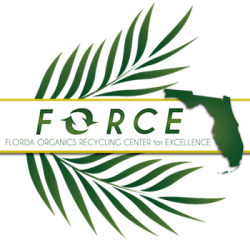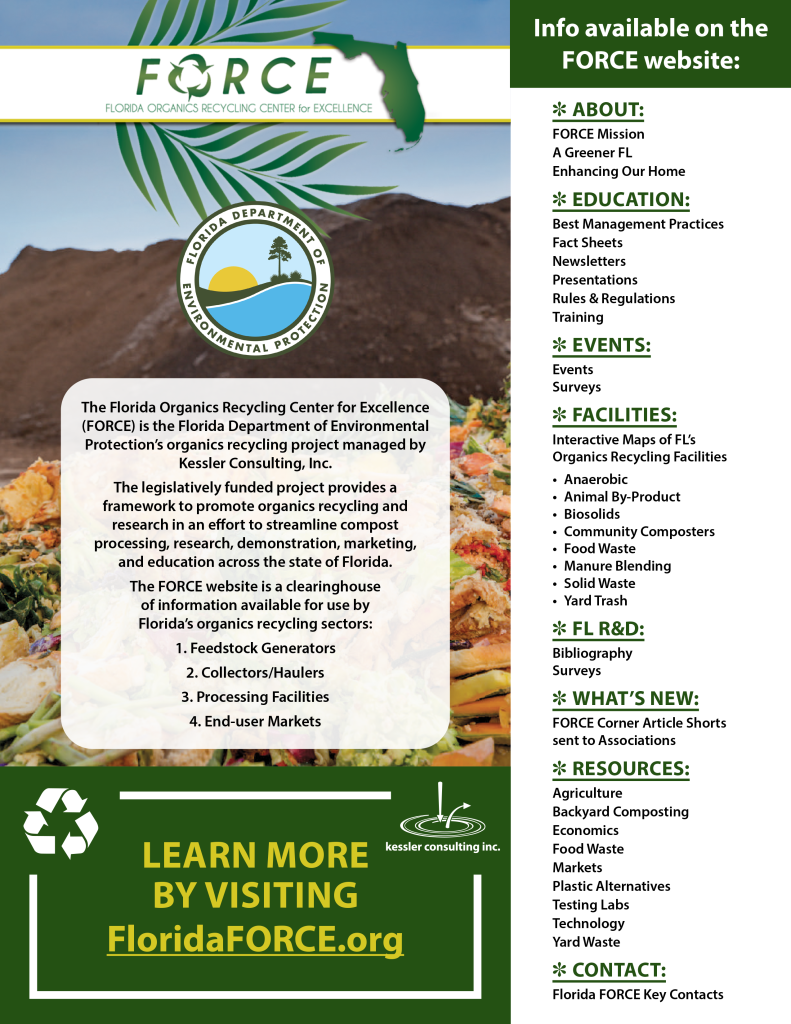SCHOOL (K-12) FOOD WASTE REDUCTION
Food waste reduction and composting in schools (K-12) is being promoted by the Florida Department of Agriculture and Consumer Services (FDACS), University of Florida Institute of Food and Agricultural Sciences (IFAS) and the Florida Department of Protection (FDEP) Waste Reduction Section.
According to the USDA, K-12 schools have a special role in not only reducing, recovering, and recycling food waste on their premises, but also in educating the next generation about recovering wholesome, excess food for donation, and about reducing food waste to conserve natural resources. This page is intended to provide information and resources to begin various types of food waste donation and composting programs in a Florida School.
FOUR COMMON FOOD RECOVERY METHODS
1. Food Gleaning
Gathering leftover crops after harvest.
2. Perishable Food Rescue
Collecting perishable produce from retail and wholesale generators.
3. Nonperishable Food Collection
Collecting long shelf life processed foods.
4. Food Rescue
Collection prepared foods from the food service industry.
FDACS' ROLE
The Department of Agriculture and Consumer Services has partnered with Florida schools and efforts on share table implementation and connecting school cafeterias with food pantries. See the attached food bank flow chart to better understand how Florida Food Banks operate and work with sub and local food distributors.
Additionally, please visit the Food Connect Group's website to learn more about the phone APP FDACS hopes to implement in the State of Florida in the near future. Currently the APP is being piloted in Broward County as a starting point.
Contact FDAC
For more information about this program, please contact Melanie Mason, FDACS at:
Phone: (850) 617-7165
Email: Melanie.Mason@FreshFromFlorida.com or InfoFNW@freshfromflorida.com
SCHOOL WASTE CHALLENGE
To join the U.S. Food Waste Challenge, organizations and businesses provide information on what they are doing in their operations to reduce, recover and/or recycle food loss and waste.
The Challenge’s inventory of activities will help disseminate information about best practices, and stimulate the development of more ideas. The inventory of activities and participants will also provide a snapshot of the country’s commitment to, and successes in, reducing, recovering, and recycling food waste.
The USDA and EPA’s Food Waste Challenge page has been removed from the USDA site, in the meantime please refer to this link for further information go to this link.
ADDITIONAL SCHOOL RESOURCES
Below is a list of resources and educational materials to support schools in their quest to reduce food waste.
Department of Health
The operation of using compost in school gardens to produce vegetables that can be served in school cafeterias falls under exemption in Chapter 62-709 for backyard composting or small-scale composting (under 100 c. yds.), as long as composting guidelines are followed, including disinfection and temperature monitoring.
USDA
For youth gardens, the USDA recommends using only commercial compost on vegetables, and using food waste compost on ornamentals. Some districts outside Florida use vegetable compost on vegetable gardens, but require very strict record keeping and maintenance practices, including a compost log.
Please see the links below for supporting documentation and studies.
The USDA has a page dedicated to K-12 Schools reducing food waste at this link: USDA's website on K-12 Schools Reducing Food Waste
USDA on Food Safety Tips for School Gardens USDA SCHOOL GARDENS
USDA Garden, Compost & Waste Reduction Project: This link provides access to a USDA flyer on school gardens and building healthy habits in K-12 schools. USDA SCHOOL GARDENS FLYER
USDA Guide to Conducting Student Food Waste Audits in Schools: Part of the USDA and EPA’s Food Waste Challenge USDA GUIDE FOR STUDENT FOOD WASTE AUDITS
USDA Memo “Guidance on the Food Donation Program in Child Nutrition Programs”: USDA MEMO
USDA Creative Food Waste Reduction Ideas: This USDA flyer provides creative ideas for reducing food waste in K-12 schools. USDA FOOD WASTE REDUCTION FLYER
USDA Booklet – What You Can Do To Help Prevent Food Waste: HELP PREVENT WASTED FOOD
USDA Flyer on Food Dating for Safety: FOOD DATING FLYER
EPA Food Waste Research FOOD WASTE RESEARCH
Palm Beach County, FL School "How to Plant A Garden Guide"
This guide replaces the School Compost Guide formerly listed here in that the Guide is no longer available on their website, but the "How to Plant A Garden Guide" is located thru this link and discusses compost too. HOW TO PLANT A GARDEN GUIDE
SCHOOL GARDENS
School gardens are an excellent way to get fresh produce into classrooms and cafeterias. In addition to fresh food, they also provide students with a living classroom, where concepts related to science, math, agriculture, and nutrition can be learned and applied.
Along with other topics, students can learn about bugs found in the garden, the effects of water and sunlight on plant growth, how to keep weeds out of gardens, and about animals that visit the garden. A school garden is a great tool to help teach children about nature, and teachers can even incorporate school garden lessons that tie into math, writing, science, and history.
SCHOOL GARDEN RESOURCES & PLANNING
These documents are intended to provide support for planning and implementing a school garden.
Public Health and Law Policy on Serving School Garden Produce in the Cafeteria: SERVING SCHOOL GARDEN PRODUCE
USDA memo on Farm to School and School Garden Expenses: USDA MEMO
IFAS Grow to Learn Guide: IFAS GROW TO LEARN GUIDE
IFAS School Gardens, A Growing Part of School: IFAS SCHOOL GARDENS
FDACS' Website for School Gardens: FDACS SCHOOL GARDENS
SHARE TABLES
WHAT ARE SHARE TABLES?
Share Tables are designated stations where children may return whole and/or unopened food or beverage items they choose not to eat. These items are then made available to other children who may want or need another serving during or after the meal service. There are schools in Florida and across the US that have implemented these types of programs.
ADDITIONAL RESOURCES
View the information below to learn more about share tables, and how to implement them at your school.
Share Table information sheet from the University of Arkansas: UA SHARE TABLE INFO
COMMON QUESTIONS
Can food left on the share table be offered again as part of a reimbursable meal?
Yes, but the county needs to obtain approval from their local health department (each local health department may have differing rules on share tables because of concerns about keeping food at the appropriate temperatures). If approved, the meals do not need to be marked as leftovers. See USDA share table memo.
Can wrapped fruits and vegetables left on the share table be sent home with the children?
Yes, but the county needs to obtain approval from their local health department because the county would be the responsible party if any food safety issues or complaints were to arise. See USDA share table memo.

